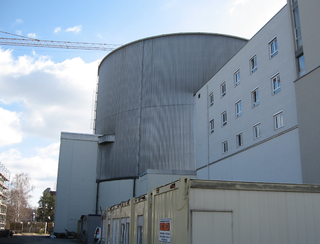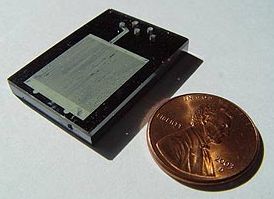
Rovira i Virgili University is located in the Catalan cities of Tarragona and Reus, Spain. Its name is in honour to Antoni Rovira i Virgili.

Forschungszentrum Jülich is a member of the Helmholtz Association of German Research Centres and is one of the largest interdisciplinary research centres in Europe. It was founded on 11 December 1956 by the state of North Rhine-Westphalia as a registered association, before it became "Kernforschungsanlage Jülich GmbH" or Nuclear Research Centre Jülich in 1967. In 1990, the name of the association was changed to "Forschungszentrum Jülich GmbH". It has close collaborations with RWTH Aachen in the form of Jülich-Aachen Research Alliance (JARA).

Friedrich–Alexander University Erlangen–Nürnberg is a public research university in the cities of Erlangen and Nuremberg in Bavaria, Germany. The name Friedrich–Alexander comes from the university's first founder Friedrich, Margrave of Brandenburg-Bayreuth, and its benefactor Christian Frederick Charles Alexander, Margrave of Brandenburg-Ansbach.

The Technische Universität Braunschweig, commonly referred to as TU Braunschweig, is the oldest Technische Universität in Germany. It was founded in 1745 as Collegium Carolinum and is a member of TU9, an incorporated society of the most renowned and largest German institutes of technology. It is commonly ranked among the top universities for engineering in Germany. TU Braunschweig’s research profile is very interdisciplinary, but with a focus on aeronautics, vehicle engineering including autonomous driving and electric mobility, manufacturing, life sciences, and metrology. Research is conducted in close collaboration with external organizations such as the German Aerospace Center, Helmholtz Centre for Infection Research, several Fraunhofer Institutes, and Germany's national metrology institute (PTB), among many others. As one of very few research institutions of its type in the world, the university has its own research airport.

Forschungsreaktor 2 (FR2) was the second nuclear reactor built in and by Germany after restrictions on nuclear research imposed as a result of the Second World War were lifted in 1955. Construction began in 1957 in Eggenstein-Leopoldshafen/BW. The organization charged with the project evolved into the Kernforschungszentrum Karlsruhe (KfK), which in turn evolved into the present day Karlsruhe Institute of Technology (KIT).

The Karlsruhe Institute of Technology (KIT) is a public research university and one of the largest research and educational institutions in Germany. KIT was created in 2009 when the University of Karlsruhe, founded in 1825 as a public research university and also known as the "Fridericiana", merged with the Karlsruhe Research Center, which had originally been established in 1956 as a national nuclear research center.

The work of the Helmholtz Centre for Environmental Research – UFZ covers both basic research and applied research.
ASCAMM Foundation is a Technology Center located near Barcelona, at the Vallès Technology Park. the origin of this Foundation was the Catalan Association of Enterprises Mould-Makers and Die-Makers, in Catalan: Associació Catalana d'Empreses constructores de Motlles i Matrius.

The Helmholtz-Zentrum Dresden-Rossendorf (HZDR) is a German research laboratory in Dresden and member of the Helmholtz Association of German Research Centres. Research is conducted in three of the Helmholtz Association's research areas: matter, health, and energy. While the research center was formerly known as Forschungszentrum Dresden-Rossendorf, the research site dates back as far as 1956, when the Zentralinstitut für Kernforschung in East Germany was founded.
Shaanxi University of Science & Technology is a university located in Xianyang, Shaanxi province, China.

The GEOMAR - Helmholtz Centre for Ocean Research Kiel (GEOMAR), former Leibniz Institute of Marine Sciences, is a research institute in Kiel, Germany. It was formed in 2004 by merging the Institute for Marine Science with the Research Center for Marine Geosciences (GEOMAR) and is co-funded by both federal and provincial governments. It was a member of the Leibniz Association till 2012 and is coordinator of the FishBase Consortium. Since 2012 it is member of the Helmholtz Association and named GEOMAR - Helmholtz Centre for Ocean Research Kiel. The institute operates worldwide in all ocean basins, specialising in climate dynamics, marine ecology and biogeochemistry, and ocean floor dynamics and circulation. GEOMAR offers degree courses in affiliation with the University of Kiel, and operates the Kiel Aquarium and the Lithothek, a repository for split sediment core samples.
The Institute for Technology Assessment and Systems Analysis (ITAS) is a research facility of the Karlsruhe Institute of Technology (KIT) in Karlsruhe, Germany. It was founded on 1 July 1995 as successor of different institutions. ITAS came into being after a merger of the University of Karlsruhe (TH) and Research Center Karlsruhe on 1 October 2009. The institute is also a member of the Helmholtz Association of German Research Centres (HGF).

The Helmholtz Institute Ulm(HIU) carries out research and development in the area of concepts for electrochemical batteries.
Holger Martin was a German University lecturer for process engineering.

Prof. Dr.-Ing. habil. Eugeny Kenig is a Russian-German scientist and head of the chair of Fluid Process Engineering at the Department of Mechanical Engineering at University of Paderborn. He is married and has one child.
Martin Winter is a German chemist and materials scientist. His research in the field of electrochemical energy storage and conversion focuses on the development of new materials, components and cell designs for batteries and supercapacitors, lithium ion batteries and lithium metal batteries.















